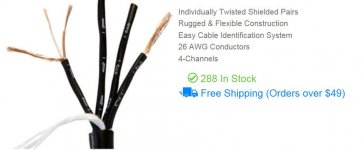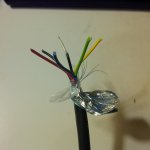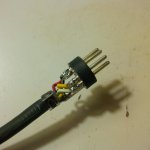I have various Uher components that connect together with 3-8 pin DIN plugs and sockets.
I wondered if people had any recommendations for cables that have enough cores to be able to make up some more interconnecting cables that I need.
Should I use a few coax cables and run some kind of cover over the bundle to keep it tidy? I fear this may be too big to fit in the end of the DIN plugs and will be a pig to solder.
Should I use some kind of multi-core data cable? This seems a good idea as there are lots of available wires inside, but they don't have the shielding braids I'm used to from making phono leads.
I have no time for snake-oil merchants, and am only looking for a reasonable way of getting more cores in a relatively small diameter cable than I can find when buying 2-core shielded RCA cable.
What do you knowledgeable types do in such a situation?
I wondered if people had any recommendations for cables that have enough cores to be able to make up some more interconnecting cables that I need.
Should I use a few coax cables and run some kind of cover over the bundle to keep it tidy? I fear this may be too big to fit in the end of the DIN plugs and will be a pig to solder.
Should I use some kind of multi-core data cable? This seems a good idea as there are lots of available wires inside, but they don't have the shielding braids I'm used to from making phono leads.
I have no time for snake-oil merchants, and am only looking for a reasonable way of getting more cores in a relatively small diameter cable than I can find when buying 2-core shielded RCA cable.
What do you knowledgeable types do in such a situation?
I wonder if a VGA cable would work? They have mini coaxes in them. You also may want to check into Cables to Go Rapid Run cables.
1.5ft RapidRun(R) Component Video and Stereo Audio Flying Lead | C2G
1.5ft RapidRun(R) Component Video and Stereo Audio Flying Lead | C2G
I would look into some "snake" cable often used between a mixing board and on stage devices for live sound applications. I like Mogami brand, but there must be other good choices as well. Performance Audio in Utah sells the Mogami cable by the foot. 8 channel is $3.13 per foot.
Audio Snake Wire | Performance Audio
Audio Snake Wire | Performance Audio
Attachments
Last edited:
Assuming that you are doing audio, I really like using stranded core cat 6, as it gets you four twisted pairs. It isn't shielded usually, but if you use half of each pair as a ground you still get four signals in one cable, with pretty darn good noise rejection.
If four conductors work, then I recommend canare star quad.
If four conductors work, then I recommend canare star quad.
Van Damme do some Van Damme - Specifications - Blue Series Studio Grade UP-OFC pre-jacketed multicore . Not sure of cost.
Keep in mind that the DIN connectors have very close spacing between pins, and don't leave a lot of room for anything much thicker than maybe #22? In a previous life as fledgling audiophile, I owned several pieces of QUAD gear, and can remember having to fabricate inter-connects and adaptors for my RCA fitted components. I can't remember ever seeing anything thicker than that.
Lingwendil's suggestion of stranded CAT 5 or 6 cable makes the most sense to me. Probably cheapest to buy an off the shelf network patch cable of sufficient length, and cut off the plugs.
Lingwendil's suggestion of stranded CAT 5 or 6 cable makes the most sense to me. Probably cheapest to buy an off the shelf network patch cable of sufficient length, and cut off the plugs.
Using half a twisted pair is a bad idea, it negates the noise rejection the twist provides. For audio get some Mogami 4 pair line level. Each pair is twisted, shielded and jacketed. And it's small gauge and is a nice flexible cable. The first choice of most high end recording studios.
Thank you all. That is very enlightening.
leadbelly (great name - I love the old bluesmen. Have you read Alan Lomax's biography?) the signals range from power between a Z140, EG740, CR240, VG840 and Report reel-to-reel Uher units to analogue stereo connections through DIN 5-pin plugs that can carry play and record signals according to pin layout, both for the Uhers and an old B&O deck (repair covered in one of my threads on here).
I am also making one connector between a DIN 4165 car plug to the input on the CR240, but that can be standard 2-core with a nice fabric cover.
Yes chrisb - I have been wondering about this. The DIN connectors can have up to 8 pins on my equipment and it's easy to over-heat the surrounding plastic as they're so small. Any multicore cable that's got too much area on each conductor simply won't fit through the end of the plug!
billshurv, ltusler, cbdb, csample - the advantages of the cables you've mentioned is that they have multiple shielded coaxial conductors, am I right? So really there are cables available (either specifically for audio, or easily pulled from computers like VGA and CAT5/6) that can be understood as multiple shielded stereo cables that I'm used to from making phono interconnects but in one package.
Lingwendil - the CAT5/6 (which I'd know as ethernet?) can be used with one half of a twisted pair as a rudimentary shield, instead of the braid I'm familiar with. Correct? Grounded at one end &c.? Although cbdb disagrees.
leadbelly (great name - I love the old bluesmen. Have you read Alan Lomax's biography?) the signals range from power between a Z140, EG740, CR240, VG840 and Report reel-to-reel Uher units to analogue stereo connections through DIN 5-pin plugs that can carry play and record signals according to pin layout, both for the Uhers and an old B&O deck (repair covered in one of my threads on here).
I am also making one connector between a DIN 4165 car plug to the input on the CR240, but that can be standard 2-core with a nice fabric cover.
Yes chrisb - I have been wondering about this. The DIN connectors can have up to 8 pins on my equipment and it's easy to over-heat the surrounding plastic as they're so small. Any multicore cable that's got too much area on each conductor simply won't fit through the end of the plug!
billshurv, ltusler, cbdb, csample - the advantages of the cables you've mentioned is that they have multiple shielded coaxial conductors, am I right? So really there are cables available (either specifically for audio, or easily pulled from computers like VGA and CAT5/6) that can be understood as multiple shielded stereo cables that I'm used to from making phono interconnects but in one package.
Lingwendil - the CAT5/6 (which I'd know as ethernet?) can be used with one half of a twisted pair as a rudimentary shield, instead of the braid I'm familiar with. Correct? Grounded at one end &c.? Although cbdb disagrees.
Kaidanovsky, nice summary of the responses. The professional audio cables suggested from Mogami and Van Damme are shielded twisted pair and designed for audio frequency signals, I'm not sure about the construction of the VGA cable. It seems likely that you could get a signal through any of the cables, and determining if one "sounds" better than another would require building both options and listening to them. If I were in your place, I would verify that the professional audio cables would physically fit into the connector and use that, because I think it is most likely to work well. It will be interesting to read about your choice and results.
Thanks csample. Yes, I'm sure I could get a signal through, and as these are small interconnects to link elements of a stack, with a few longer auxiliary or recording cables I am not too worried about the sound, more the physical limitations of the connectors!
I was thinking the shielding would be an advantage, but not being a studio engineer wasn't aware that there were cables with multiple shielded cores available. I might try with the CAT5/6 cable first as I have some in the box of computer bits and it's cheaper than buying specialist cable. Always a major factor in DIY!
Is there an engineering consensus on whether it's worth shielding cables of this short length at line level, if we put aside listening rooms and audiophilia for a moment? The viability of twisted pairs versus braids seems to depend on it.
I was thinking the shielding would be an advantage, but not being a studio engineer wasn't aware that there were cables with multiple shielded cores available. I might try with the CAT5/6 cable first as I have some in the box of computer bits and it's cheaper than buying specialist cable. Always a major factor in DIY!
Is there an engineering consensus on whether it's worth shielding cables of this short length at line level, if we put aside listening rooms and audiophilia for a moment? The viability of twisted pairs versus braids seems to depend on it.
As to the question of shielding on shorter lengths of cable - perhaps I've just been lucky, but I've built a few based on either simple UTP, or more elaborate dual spiral (barber-pole) or three conductor braids with "floating shield".
None of the systems I used them in were prone to hum / noise pick-up.
There are companies offering pre-made fully shielded DIN interconnects in most of the likely termination configurations required. At the prices listed, I'd be inclined to buy, not build.
https://soundsheavenly.com
None of the systems I used them in were prone to hum / noise pick-up.
There are companies offering pre-made fully shielded DIN interconnects in most of the likely termination configurations required. At the prices listed, I'd be inclined to buy, not build.
https://soundsheavenly.com
I've just made one up with some cable my father had left over from re-wiring our boat. I've been out of the country and the repair of the CR-240 cassette deck the cables were initially for has taken far longer than I'd expected.
I think this is not far off what it is: Def Stan 7-2 six-core (PDF Datasheet).
This has no noticeable hum pickup, using the braid as the ground pin at each end. I suppose actually I should only have one end attached... It's quite stiff so still holds its twist from being in a coil, so it has its limitations as an interconnect cable.
I'll try some of the other suggestions...
I think this is not far off what it is: Def Stan 7-2 six-core (PDF Datasheet).
This has no noticeable hum pickup, using the braid as the ground pin at each end. I suppose actually I should only have one end attached... It's quite stiff so still holds its twist from being in a coil, so it has its limitations as an interconnect cable.
I'll try some of the other suggestions...
Attachments
That's a good tip, Kay Pininha. There are so many cable types around that filtering them online is a real pain! I've found some of what you mention here: https://cpc.farnell.com/pro-power/j...screened-audio/dp/CBBR4161?st=screened cables
This could be good, but I'm going to need to do a lot of audio to buy 100m of it!
Speedskater: won't that end up a bit stiff? I fear that's what's the trouble with the ones I've made up. They work, but it's hard to get them to sit right, and difficult to connect auxiliary sources as they don't flex very much.
This could be good, but I'm going to need to do a lot of audio to buy 100m of it!
Speedskater: won't that end up a bit stiff? I fear that's what's the trouble with the ones I've made up. They work, but it's hard to get them to sit right, and difficult to connect auxiliary sources as they don't flex very much.
- Status
- This old topic is closed. If you want to reopen this topic, contact a moderator using the "Report Post" button.
- Home
- Design & Build
- Construction Tips
- Multicore cable for DIN interconnects?


